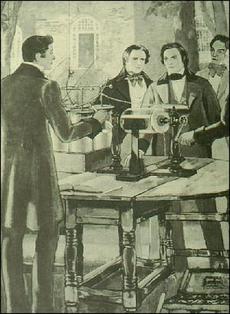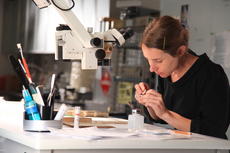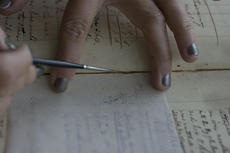Blogs across the Smithsonian will give an inside look at the Institution’s archival collections and practices during a month long blogathon in celebration of October’s American Archives Month. See additional posts from our other participating blogs, as well as related events and resources, on the Smithsonian’s Archives Month website.

On a hot August 3, 1838, Joseph Henry, the first secretary of the Smithsonian, was conducting innovative experiments on electromagnetism in his laboratory at Princeton University where he was also a professor of natural philosophy. On the table next to him was a large leather-bound accountant’s ledger from the 1700s, thriftily repurposed as a scientific notebook.

On this particular day, he was testing magnetism with hot iron filings. Imagine, if you will, Joseph Henry excitedly writing and drawing his results in the margins of the account book. As he soldered wires together and heated ferrous iron filings, pieces of his experiment flew unnoticed onto the pages of the opened notebook. The tip of his quill pen snapped off as he quickly recorded his results, slipping inside the gutters of the binding. Then a sliver of the lead broke off from his experimentation equipment, lost forever inside the book . . . or was it?
The process of scientific discovery is often one of the most interesting things about working in the conservation lab of the Smithsonian Institution Archives. Whether testing cellulose nitrate film with Fourier transform infrared spectroscopy or experimenting with physics on a box of Wheaties, my focus is on examining the physical evidence of the materials that come into the lab. Using chemistry and visual observation, I get to analyze the aging characteristics of the ink and paper, study our books' sewing structures and investigate oil stains or water damage. It is always fascinating to discover that a particular sheet of paper was made in a small village in France or that Thomas Jefferson used ink made from gall nuts.
 Even the dirt on a book or paper document can provide valuable context to its narrative and be historically significant. Consider the dirt on a buried Roman artifact - should it be cleaned off for aesthetic reasons? Or left alone, as it is a necessary link to its past? These are the types of questions I must face when trying to preserve the Smithsonian's materials for future generations to enjoy and research. And as it turns out, the "dirt" on my most recent treatment, Joseph Henry's Record of Experiments Book I, has given us quite the story to tell. And we're quite glad we didn't sweep it away into the dustbin.
Even the dirt on a book or paper document can provide valuable context to its narrative and be historically significant. Consider the dirt on a buried Roman artifact - should it be cleaned off for aesthetic reasons? Or left alone, as it is a necessary link to its past? These are the types of questions I must face when trying to preserve the Smithsonian's materials for future generations to enjoy and research. And as it turns out, the "dirt" on my most recent treatment, Joseph Henry's Record of Experiments Book I, has given us quite the story to tell. And we're quite glad we didn't sweep it away into the dustbin.
The story unfolded as my colleague Nora Lockshin and I began disbinding and cleaning Henry's notebook in preparation for digitization. We found buried deep within the book's binding a significant amount of not-your-ordinary "dirt," made up of tiny black and red crystalline granules, miniscule metal fragments, quill nubs, red waxy material, rust, and charcoal-like substances. Curious, as to whether these might be tangible links to his experiments, I carefully collected samples for future testing and analysis.
We brought the samples to the Smithsonian's Museum Conservation Institute (MCI) "Open Lab" day, where physical scientist Nicole Little used X-ray diffraction (XRD) technology to test and analyze them.
Nicole determined that the reddish and black crystalline dirt, which we found on the pages where Joseph Henry writes of using iron filings, is composed of the ferrous minerals hematite and grossular. Could these be common in iron filings at the time? The shiny metal fragment found on the page where he writes of using a lead plate is indeed pure lead. Are these remnants of his experiments, perhaps? Look soon for the digitized images of the entire Book 1, so you can see for yourself how his experimentation process worked! Many thanks to Smithsonian MCI scientist extraordinaire Nicole Little for her help in analyzing the "dirt" that has brought Henry's experiments back to life.
Related Resources
- A Life in Science - Joseph Henry exhibit, Smithsonian Institution Archives
- Smithsonian Channel - Stay tuned for an upcoming show on the Smithsonian in the Civil War, featuring the diaries of Joseph Henry’s daughter, Mary Henry
Related Collections
- Record Unit 7001 - Joseph Henry Collection, 1808, 1825-1878, and related papers to circa 1903, Smithonian Institution Archives
Produced by the Smithsonian Institution Archives. For copyright questions, please see the Terms of Use.

Leave a Comment